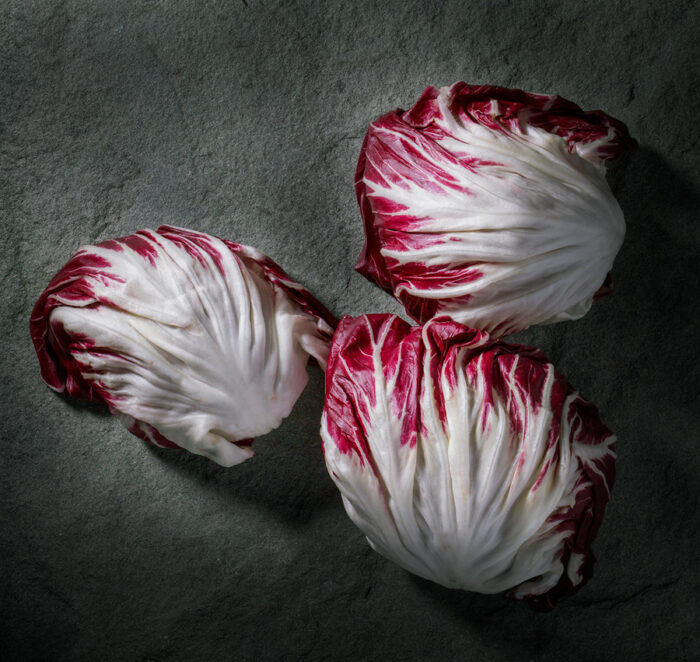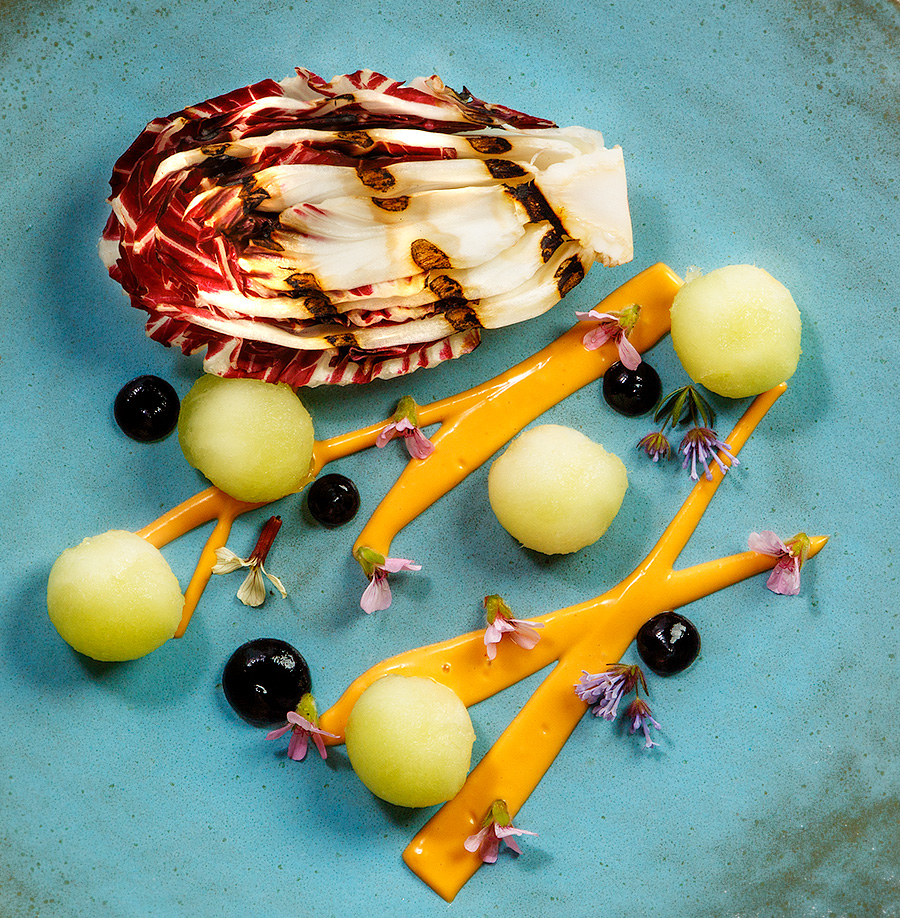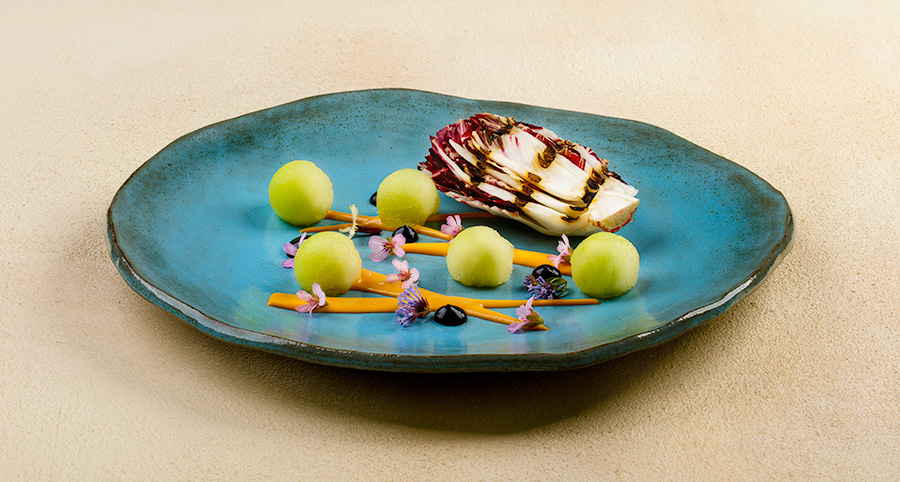Chipotle Mayonnaise Pairs Well with Grilled Radicchio
At some point, radicchio will get its day in the sun. That’s not what it gets on its way to the grocery aisle, of course. Radicchio is a chicory, and as with Belgium endive (another chicory, not a true endive), most commercially grown radicchio achieves its final appearance from forcing in the dark.

In the food world, vegetables seems to rise and fall in popularity every few years. Brussels sprouts become a thing four or five years ago, sprouting up on menus all at once and then disappearing again. Cauliflower has been the celebrity vegetable of the year several times. Beets, parsnips, and peas have each gotten their share of center stage.
But despite its dazzling beauty, outside of Italy radicchio has never caught on. It’s tempting to write it off as too bitter to work with, but we don’t do that with other foods, or there’d be no coffee, no artichokes, no dark chocolate. Arugula is bitter, yet it’s wildly popular – at least among the greens-grazing crowd. But radicchio doesn’t get even an obscure spot among the garnishes at the salad bar, nor typically any mention on a restaurant menu.
I suspect it hasn’t caught on because cooks aren’t quite sure how to deal with it. The unfortunate reality is that the longer radicchio cooks the better it tastes, and the worse it looks. It’s like red onions that way, except radicchio starts off looking a great deal better and ends up looking quite a lot worse. Savory recipes that incorporate radicchio tend to give it a long-cooked treatment, but then crowd it in among more attractive ingredients that draw the eye away from the soft brown bits that once were so bright they could have adorned a Christmas tree.
Radicchio can be served raw, of course, but unless shaved thinly it’s not especially delicious that way. The closest to a happy medium that I’ve found is to cut the head into thin slabs and then sear them very briefly on a screaming-hot grill. By serving it when just warmed in the center, radicchio keeps its original vibrancy but seems more thoroughly cooked than is actually the case because of the prominent grill markings.
Today I’m plating it with a mayonnaise flavored with smoked jalapenos, along with some Canary melon to add sweetness to the dish. The mayonnaise could be made with an egg as the emulsifier, but I’m using aquafaba to keep the dish entirely vegan. The piquant sauce and the bitterness of the radicchio play off well against each other.

I’ve garnished the plate with dots of balsamic fluid gel along with some edible flowers. The final plate is essentially a deconstructed salad course.

Grilled Radicchio with Chipotle Mayonnaise Recipe
Serves 4-6
2 heads of radicchio
1 small can of chipotles in adobo sauce
2 T (30 g) c water
1 T (15 g) white vinegar
1/4 c (60 g) aquafaba
1 t (5 g) Dijon mustard
1/8 t (0.7 g) salt
1 1/2 c (360 g) neutral oil (like Canola, safflower, or vegetable oil)
Garnishes
Make the chipotle mayonnaise
Put a medium strainer over a bowl and spoon the contents of a small can of chipotle chilies into the strainer. Use a spatula to press the sauce and soft flesh of the rehydrated jalapenos through the strainer. Discard the seeds and other solids that don’t pass through the mesh. Reserve the sauce.
In the bowl of a stand blender put the water, vinegar, aquafaba, mustard, and two tablespoons of the chipotle sauce. (Reserve the rest for another use.) Add the salt and pulse briefly to combine. If the mixture doesn’t come up far enough in the blender bowl to cover the blades, add a little more water (typically just a tablespoon or two) until it does.
Turn the blender up to medium speed. Starting very slowly (about a teaspoon of oil at a time) add the oil and let the blender process it into the water-based ingredients, which it will do almost instantly. Continue adding oil slowly at first, then after a few seconds add it more rapidly. The entire addition should take at least 10 seconds, but doesn’t need to be drawn out much beyond that so long as the initial oil is added in small quantities.
If the mayonnaise becomes thicker than you want it before all the oil is incorporated, add a teaspoonful of water, which will loosen the mixture. If it’s formed an emulsion but isn’t as thick as you’d like, turn the blender on again and add more oil.
Grill and plate the radicchio
Preheat the grill. Ideally get the grates to the point of searingly, screamingly hot.
Cut each radicchio head in vertical slices so that a portion of the root base holds each slice together. Lay the slices on a sheet tray and brush each side with oil, then season them on both sides with salt and pepper.
Just before putting them on the grill, turn the grill heat down (or even entirely off). Lay the slices on the grill grates and press each one down against the grill for ten or fifteen seconds to mark them. Turn them over and mark the other sides. Then either remove them from the grill and serve them semi-raw (which preserves almost all their original color), or grill them over fairly high heat, turning them periodically, until they darken and wilt to the desired degree of doneness.
Either way, put some of the chipotle mayonnaise on each plate, add the grilled radicchio and whatever garnishes you prefer, and serve.


Like this Recipe? Leave a Comment.
Your email address will not be published.